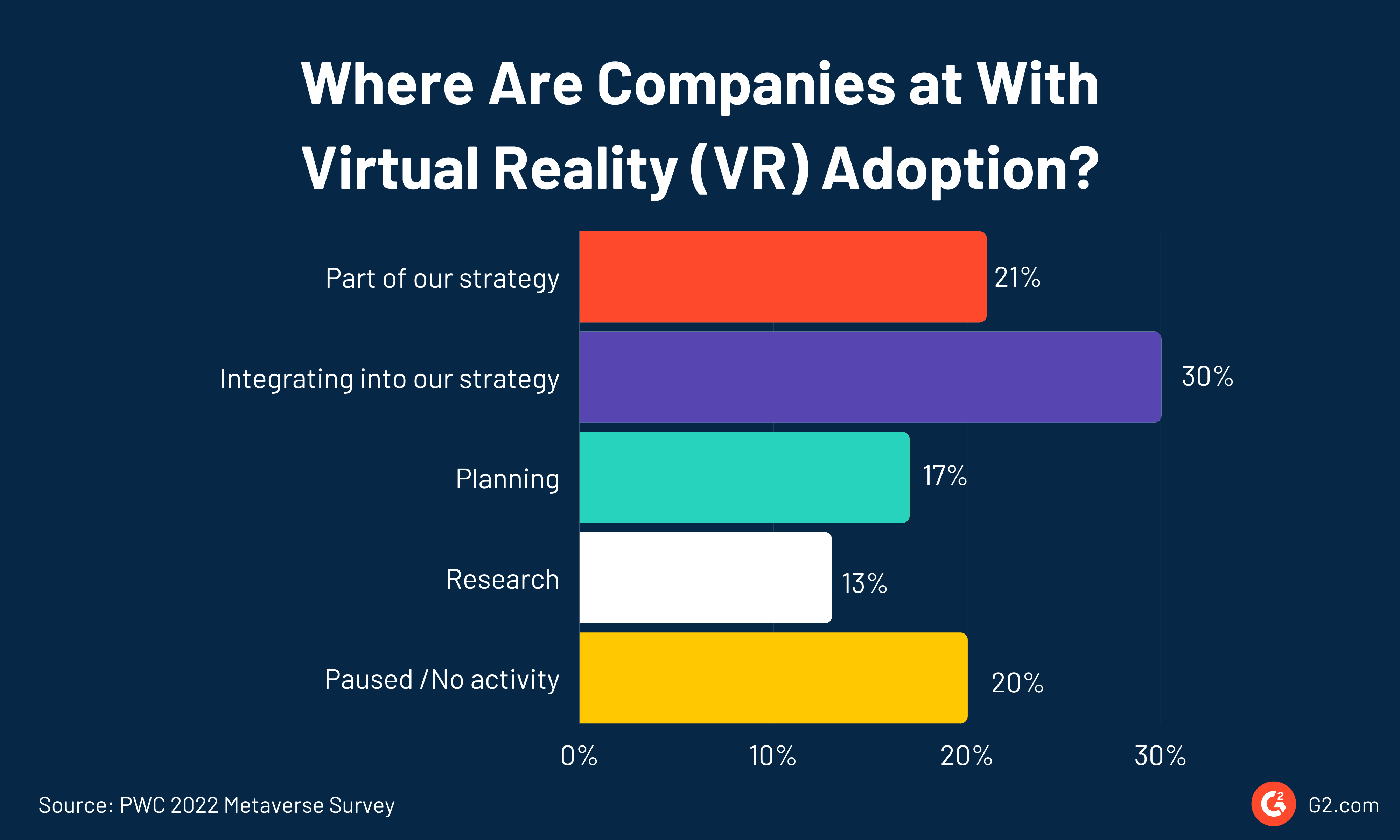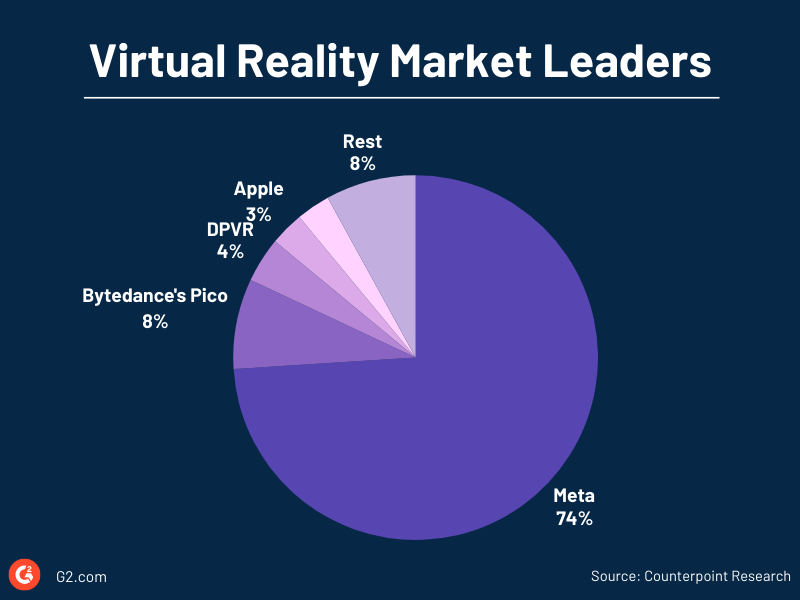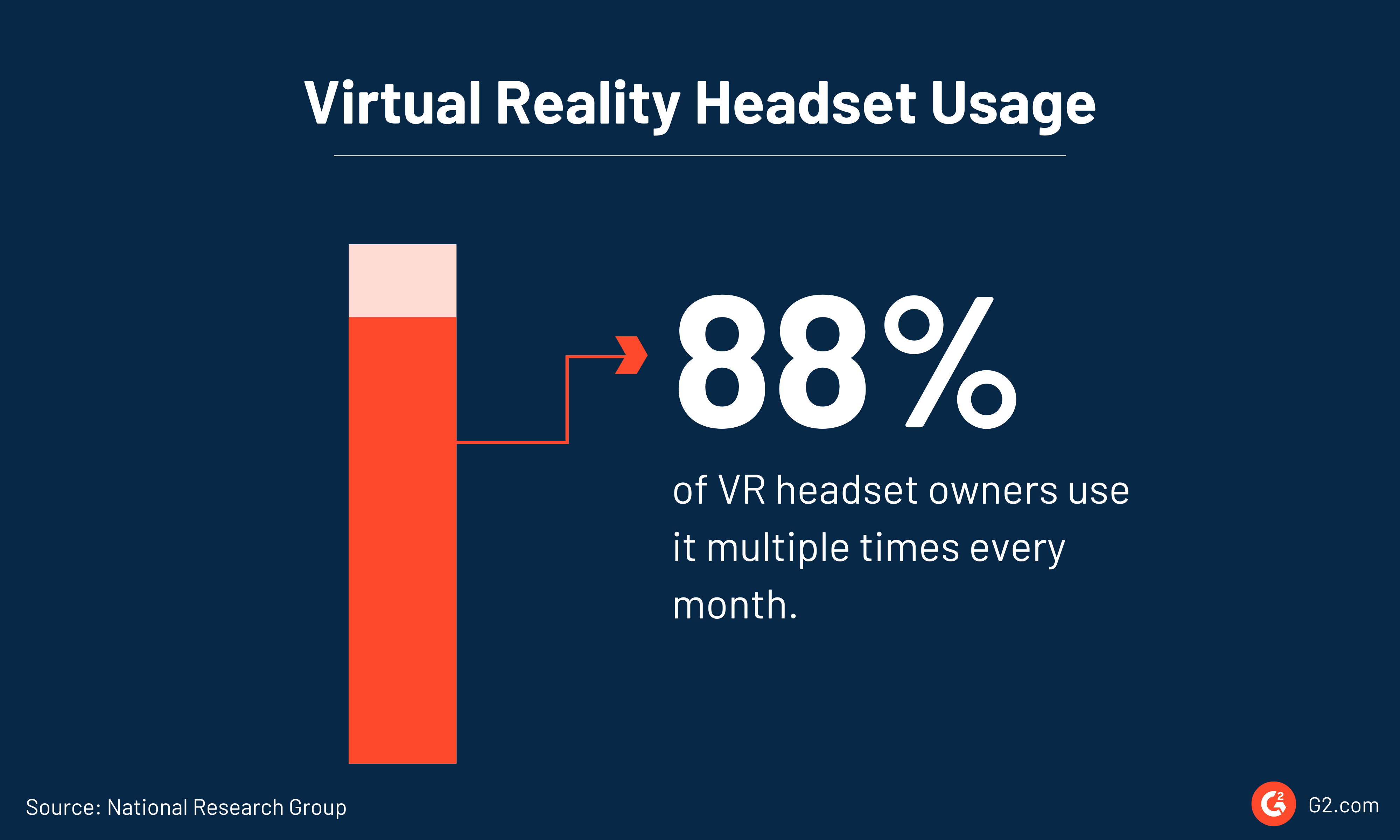Remember the movie “The Matrix”, where humans lived in a simulated digital environment run by machines?
While the film was dystopian, it was somewhat prophetic about immersive digital technologies. Today, virtual reality (VR) software tricks you into believing the digital environment is real. Thankfully, the technology is not as bleak as shown in the film.
VR has found numerous applications for enterprises and common consumers, from games and movies to training and tourism. The emergence of the metaverse as the next iteration of the internet has also fuelled the VR industry. This has led to the question, "Is VR the future?."
Here are some interesting statistics that answer this question. These facts show how VR is currently used and predict future years.
Top 5 virtual reality statistics for 2025
- About 53 million US adults currently own a VR system.
- The global VR market size reached $15.8 billion in 2023
- By 2029, the global AR and VR user base is projected to grow to 3.7 billion users.
- 1 in 2 companies is actively integrating VR into their business strategies, emphasizing its enterprise potential.
- 48 of US consumers have had at least one VR experience.
Virtual reality user statistics
VR immerses users in simulated digital environments with devices like headsets, earphones, handsets, and other tools. Like augmented reality (AR), VR is still in its discovery stages. Consumers are fairly aware of the technology, but there’s room for improvement in accessibility and potential security threats. Check out these statistics on consumer interest in VR technology.
- 171 million people use VR technology globally.
- The virtual reality user penetration rate is projected to be 52.8% in 2024 and is expected to increase to 55.9% by 2028.
- The number of AR & VR market users worldwide is expected to reach 3.7 billion users by 2029.
- More than 30%of Gen Z and millennials consumers have tried VR compared to 26% of Gen X and 13% of Boomers.
- 8 out of 10 consumers who have tried VR describe their experiences as either “very positive” or “somewhat positive”.
- More than 4 out of 10 consumers say they’re interested in VR and willing to use it under the right circumstances.
- Nearly 37% of US consumers are “excited” about spending time in VR.
- One-third of US adults believe VR will positively impact society.
-
1 out of 2 companies is either in the process of incorporating VR into their strategy or has already integrated VR into at least one dedicated line of business.

- By 2030, enterprise users will dominate the VR segment, accounting for more than 60% of total revenue.
- 1 in 5 Americans is interested in attending a work meeting in VR.
-
The average revenue per user (ARPU) is expected to be $11.9.
Related: Learn about the history, types, benefits, and real-life examples of virtual reality.
Virtual reality market statistics
With the use cases of VR increasing every day, the market size of the technology is also multiplying. The most robust demand for VR currently comes from industries in the creative economy - specifically, gaming, entertainment, retail, and live events. Furthermore, VR has found broader applications in diverse industries like healthcare, education, the military, and real estate. Its application in the metaverse has also triggered a flurry of developments.
- The market size of immersive technologies, including VR, AR, and mixed reality technologies, is expected to reach about $1.2 trillion by 2035.
- The VR market size in 2023 was $15.8 billion, reflecting steady growth in the industry.
- VR hardware accounted for $9.4 billion, emphasizing its importance in the VR ecosystem.
- The VR headset market was worth $9.2 billion in 2023, showcasing its significant share in the VR landscape.
- VR gaming contributed $2.8 billion in 2023, showing its role as a key segment within the market.
- The global VR market is projected to reach $227.34 billion by 2029, up from $16.67 billion in 2022.
- The virtual reality market is expected to grow at an annual rate of 10.77% (CAGR 2024-2028), resulting in a projected volume of US $58.1 billion by 2028.
- The VR market is projected to generate a revenue of US $38.6 billion in 2024.
- Revenue in both AR and VR markets is anticipated to touch $40.4 billion in 2024.
- The VR headsets market is projected to generate a revenue of $10 billion in 2024. ·
By industry
Here’s the industry-wide breakdown of how much the VR market is expected to grow in the coming years.
- Creative industries such as gaming, live events, video entertainment, and retail are expected to fuel half of the VR market in 2025.
- The global gaming market size is anticipated to grow at a compound annual growth rate (CAGR) of 22.7% from 2023 to 2030.
- The VR gaming market is expected to reach $53.44 billion in 2028.
- The AR/VR market in the aviation industry is expected to hit $23.6 billion in 2031.
- VR in retail is estimated to hit $19 billion by 2030.
- The size of VR in the manufacturing industry will increase to $14.8 billion in 2026, up from $924.7 million in 2018.
- VR in the healthcare market is reckoned to grow to $6.20 billion by 2029, up from $628 million in 2022.
- The global virtual tourism industry is set to rise over $24 billion by 2027, up from just $5 billion in 2021.
Virtual reality market leaders
Some of the biggest tech companies have joined startups and game creators in the race to dominate the VR market. Facebook, for instance, rebranded itself as Meta, signaling its intention to offer immersive experiences. Know who is competing to sell the best VR devices and experiences.
- Meta holds 74% of the VR headset market, followed by ByteDance's Pico, with a 8% share.
- China’s DPVR holds a 4% market share, followed by Apple and Sony with a 3% share each.

- Meta's AR and VR division, Reality Labs, earned $2 billion in revenue from its sales of Quest headsets and games, apps, and services.
- Meta has sold more than 20 million units of Oculus Quest VR headsets cumulatively.
Virtual reality job statistics
As companies move towards creating immersive digital experiences, there’s increasing demand for people skilled in immersive technologies.
- Despite AR and VR roles comprising a small slice of global job postings, there's 154% increase in job postings over the past five years.
- The U.S., India, and Germany are at the forefront of investing in AR/VR's potential.
-
The average salary of a VR developer in the US is $108,471 per year.
Virtual reality adoption statistics
VR technology adoption is a slow burn. Price, lack of availability, and other factors prevent typical consumers from having a spark of interest in VR. However, statistics show that interest grows once consumers try out VR devices, and the intimidation factor fades.
- In 2024, an estimated 72.2 million Americans are diving into immersive experiences with VR systems.
- Meanwhile, 95.5 million Americans are exploring augmented reality (AR), blending the virtual and real worlds seamlessly.
- About 53 million Americans own a VR device.
- More than a quarter of teens (26%) own a VR device.
- An additional 14 million US adults will likely purchase one in the next six months.
- 35% of VR users expect to increase their VR spending over the next six months.
- 66% of users say VR content needs to provide something they can’t get from traditional films, TV, or games to be worth the upfront investment.
- 13% of US households have at least one VR headset.
- The VR headset market will reach $26.8 billion by 2027, up from $7.9 billion in 2021.
- VR headset users in the US are set to breach the 32 million mark, with sales of 13.9 million in 2022.
- In line with the above estimation, VR headset sales jumped 241.6% in the first quarter of 2022 alone.
- By 2024, more than 34 million VR headsets will be in use.
- 4 out of 10 consumers are excited about attending a VR concert.
-
The top features that consumers expect before choosing a VR headset are good image resolution (52%), comfortable headset and controllers (44%), high-quality audio (39%), and an easy, intuitive setup.
- Nearly 4 out of 10 Gen Z (37%) and millennial (38%) online users are extremely interested or at least very interested in attending virtual concerts of their favorite musical artists.
- More than a third of consumers are interested in using a VR headset to visit a virtual museum or art gallery (39%), socialize with friends and family (31%), or attend a fitness class (32%).
-
Nearly half of the shoppers are willing to pay extra for a product customized using immersive technologies.
Virtual reality usage statistics
As VR awareness sets in, so does VR usage. These statistics showcase the increasing numbers of consumers using virtual reality and what they use it for.
- 3 out of 10 people bought a VR device to see what the hype was all about.
- 88% of people who own a VR headset use it multiple times every month, with 60% using it more than once a week.
- 7 in 10 VR headset users play games with VR devices.
- 42% of VR device owners have used the device to watch films or TV.

- 35% of VR headset owners have used it for workouts or exercise, while 22% have used it to create music, videos, or art.
- 4 out of 10 consumers say they’d be too scared to experience a VR horror experience.
- Only 13% of consumers say they’d be open to spending more than an hour in a VR headset without taking a break.
Virtual reality problems statistics
From high costs to health issues, the multibillion-dollar industry is not without significant concerns and challenges. These statistics show the problems the VR industry needs to address before mass adoption.
- 65% of people cite cost as the reason for not owning a VR device.
- 37% of VR headset users experienced motion sickness symptoms during their last VR experience.
- More than a third of people think VR will have a negative impact on children.
- 1 out of 5 people is “moderately” or “extremely” concerned about VR security and privacy.
- 1 in 2 parents is uncomfortable with their children using VR for more than 3 hours a week.
- Almost 1 in 2 users experience harassment in social VR platforms, with female-presenting avatars being common targets.
Despite the concerns, VR remains an optimistic endeavor that many industries are embracing.
Virtual reality gaming statistics
The gaming industry has truly embraced virtual reality as devices and games pop up on the market. Devices like the Oculus Quest, the HTC Vive, and Sony Playstation VR sets are entering consumer living rooms. With devices comes the need for VR games. With the help of VR game engine software, developers are cranking out VR games more than ever, further enticing gamers to invest in these devices. Look at these statistics that show the increasing popularity of VR gaming.
- Playing games is the primary motivation for more than half of consumers to purchase a VR device.
- According to expert estimates, Meta sold 325,265 VR headsets, including all Quest versions, in just the third quarter of 2024.
- Sony Corporation had sold 600,000+ units of its second version of Play Station VR called PS VR 2.
- Revenue from VR games will hit $3.2 billion in 2024.
- More than a third of Meta’s 400 VR games have grossed more than $1 million in revenue.
- Meta’s VR game “The Walking Dead: Saints & Sinners” has grossed over $50 million in revenue on Quest.
- About 52% of US gamers believe the metaverse, a virtual world that mimics the real world using a combination of AR and VR technology, will change the game industry.
Virtual reality media statistics
The gaming industry isn’t the only one tackling the power of virtual reality. Retailers, social media platforms, and the tourism industry have much to gain from virtual reality. VR social media platforms are changing how people socialize, enabling remote interactions and further evolving how we communicate. These statistics prove the steady rise of VR in various media platforms.
- Around 3.4 million people are subscribed to the YouTube 360 channel, YouTube’s official VR channel.
- Roblox, a VR social platform, has about 88.9 million daily active users.
- About half of Roblox’s daily users are under the age of 13.
- More than a third of VR users shopped on VR platforms after testing or browsing them on VR stores in the first half of 2022.
- In the same period, 31% of VR users shopped for digital products like non-fungible tokens (NFT) from VR platforms, and 19% of VR users bought luxury goods on VR platforms.
- Products marketed with AR/VR content have a 94% higher conversion rate than those without AR/VR content.
- 4 out of 10 people are interested in shopping for real-life products in virtual worlds.
- 1 in 3 Gen Z shoppers wants to see virtual stores to browse and buy products.
- 7 in 10 young people like when brands interact with their virtual worlds.
- 61% of young shoppers are more likely to purchase from a brand that interacts with their virtual worlds.
- Almost one-fifth of consumers have used VR to help select a holiday destination.
- A quarter of tourists plan to use VR to assist them in selecting their tourist destination.
Virtual reality training statistics
VR is already known for training workers in the aviation and manufacturing industries with lifelike simulations. Its powerful visualizations improve practical understanding of a subject and enhance learning through interaction with the immersive environment. Here are some fascinating statistics that show the benefit of VR training over conventional educational methods.
- 6 in 10 Americans think VR and AR will be useful learning tools for children.
- Employees can be trained 4 times faster in VR courses than in classrooms.
- 76% increase in learning effectiveness over traditional methods.
- VR-trained employees are 4 times more focused during training than their e-learning peers and 1.5 times more focused than their classroom colleagues.
-
Surgeons trained using VR make 40% fewer mistakes than those trained conventionally.
Sources:
Seeing in believing
Numbers say it all. There is plenty of room for virtual reality to flourish in the next few years as more consumers become aware of the technology and prices become more affordable. The future is in immersive digital experiences. So, try it out.
Meet and communicate with your peers in virtual spaces with VR Collaboration software.

Soundarya Jayaraman
Soundarya Jayaraman is a Content Marketing Specialist at G2, focusing on cybersecurity. Formerly a reporter, Soundarya now covers the evolving cybersecurity landscape, how it affects businesses and individuals, and how technology can help. You can find her extensive writings on cloud security and zero-day attacks. When not writing, you can find her painting or reading.
